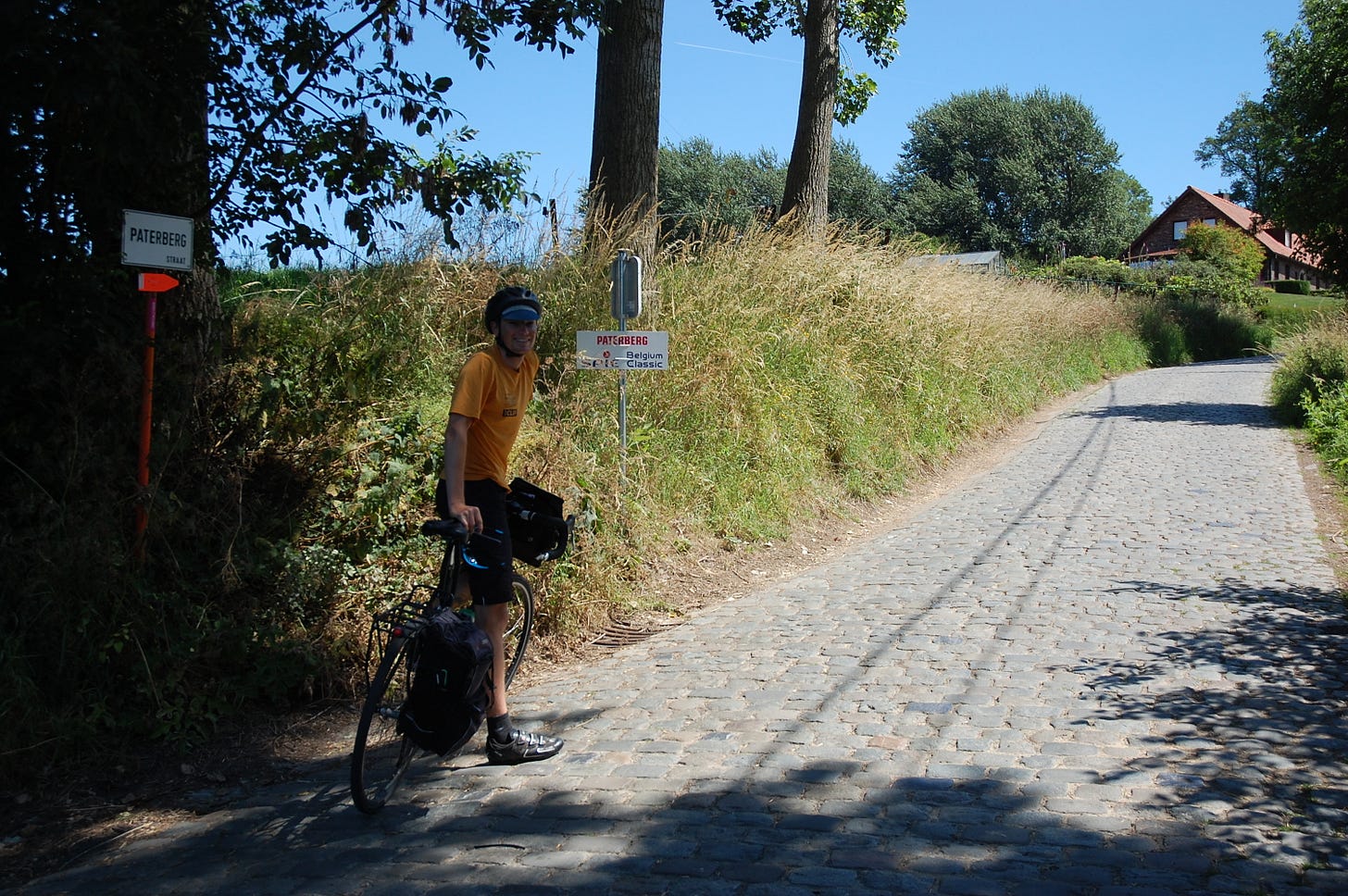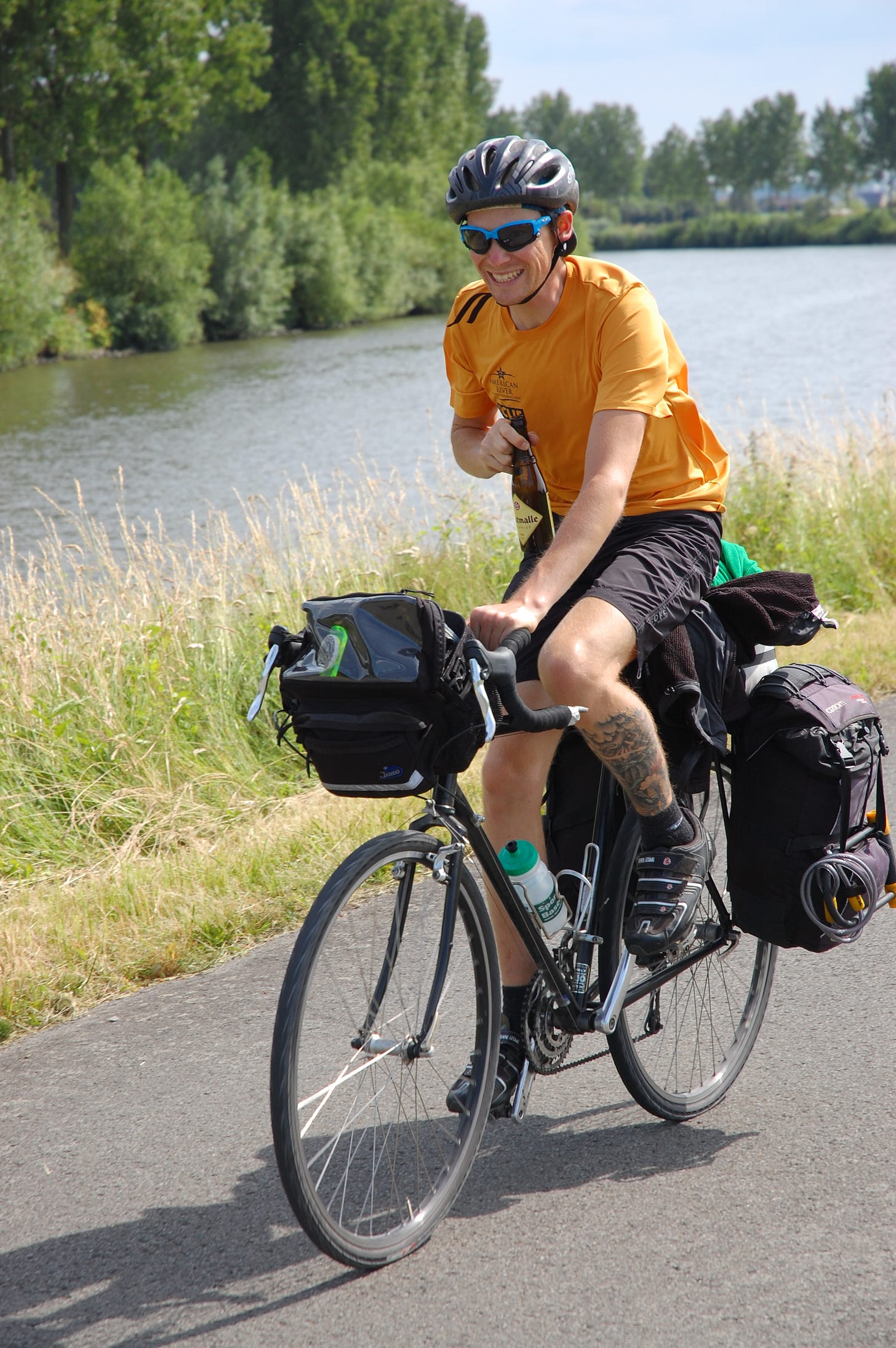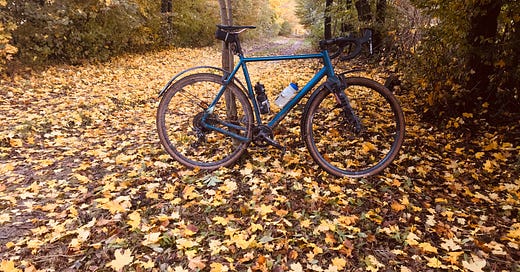10 years ago, a local pro who happened to work at the Mikes Bikes at the edge of the UC Berkeley campus told me that he’d never ride a bike with tires bigger than 32mm even for loaded bike touring. 10 years later, we raced together for the first time in 2019 at the NCNCA road district championships on the Berkeley Hills course. He whipped my ass, but now everyone was racing on tires 25-30mm wide and most people used disk brakes, previously the domain of cyclocross and bike touring.

Above: 32mm tires in 2014. Visionary or Fred?
Bike tire width has revolutionized the way we ride bikes. It led to the advent of mountain biking in the early ‘80s, for example. Over the past few years, it has created an all new category of riding by mixing the efficiency of road bikes with the versatility of mountain bikes to birth the trendy gravel bike category.
Let’s go back eight years though for why I was searching for bigger tires for my touring bike. I was planning a loaded bike tour and had worn out the outrageously large at the time 28mm tires. I was looking for more comfort, stability, and just something new. Because capitalism.
But with the advent of bikepacking and gravel bikes, the touring bike has become a bit declassee in favor of its more capable, cooler looking, and technically superior brethren—namely the gravel bike.

The pic above shows two touring bikes about to climb over the mountain and descend into Death Valley. What awaited — unbeknownst to the riders at the time — was endless OHV roads with deep gravel and sand.
Nowadays one might think “Endless gravel in one of the most picturesque places on Earth!” But let’s remember, this was (only) eight years ago. The blue bike on the left had 25mm road slicks and slime tubes while the Surly Longhaul Trucker on the right had 32mm tires pumped to 80psi. The camping gear and food weighed about 30-40 pounds on each bike.
Basically, we went nowhere super fast once we hit the deep stuff. We ended up flagging down a lost guy in a pickup on his way to Vegas. He almost rolled his truck showing us his “gold nugget.” It made for a great story, some epic riding (attempting to at least) and camping, but our equipment wasn’t up to the task.
Fast forward to today and even Tour de France race bikes have the capacity to take 32mm tires and many people choose to race (on the road no less) with tires as large as 28-32mm (although 25-28mm seem to be the most common outside of Europe where 23mm still reigns supreme).
Gravel bikes have the capacity to take even larger tires than touring bikes. Tires that would have been more at home in cross country mountain bike races just a few years ago are now considered “gravel” or “commuter” tires. My gravel bike has 43mm tubeless “gravel” tires that I run at 25 PSI during this time of year, for example.
Moreover, with so many options in bikepacking bags that you simply strap to the frame, there’s not really any need for bike racks and panniers that add huge amounts of weight, make the bike pretty unwieldy on anything other than paved road, plus it just has to be about as aerodynamic as...well just look at it.

Above: iconoclast rides antiquated bicycle with marionette style braking and shifting, navigates with compass and map somehow.
The bike touring purists will say “touring’s about seeing stuff so it doesn’t matter if the bike is heavy or not very aero. It’s about the experience, man!” Fair, but I’ve toured a bit and can tell you that a road’s a road. Sure, some roads are prettier than others, but road touring cannot compete with trail riding’s sense of exploration. If touring’s about exploring, at some point you have to leave the road behind. Touring bikes just can’t do that as well as gravel bikes can.

Above: gravel/snow tires. It’s all the same.
Wider tires, better brakes, nimbler handling all make riding gravel bikes much preferable to the humble touring bike. If you have a day on a tour where you just need to pound out miles, gravel bikes are fine for that too since they’re, you know, bikes.
Gravel bikes also have huge amounts of gear range now thanks to modern derailleurs, and are also simpler with 1x. Many touring purists tout the need to be able to fix parts during tours. A 1x drivetrain eliminates the need to fix a front derailleur since it doesn’t even have one. With 11-13 gears in the rear, you can have a gear for pretty much any situation you can feasibly pedal through. Sure, the jumps between gears might be larger than the trusty front triple, but then again you don’t have any duplicated gears to lug around or jam your chain because of a bad shift.
But touring bikes aren’t completely dead, I think. Touring bikes make awesome bike commuter rigs! They hold tons of crap, are burly, and nobody will want to steal them because they don’t look so trendy anymore. With public transit kind of sketchy with COVID, having a dedicated commuter bike to do errands around town is a great alternative to driving around or riding the bus. You could even convert it to an e-bike to do even more errands! Think of all the errands you could do! So many!

Above: my abused Surly in 2014 in Australia gathering bike boxes to return home. Also, that handlebar bag was trendy AF.
Plus, riding gravel bikes is just fun. Yesterday and today I got to explore trails around my new home in Vienna. The trails are pretty soggy and slippery with mud so it felt like ice skating at times, but it was definitely the kind of fun one could not really have with a dedicated touring bike. Sure, it’s possible, but I think you’d probably end up on the ground a few more times and you wouldn’t have that feeling of being a Speeder Bike on Endor like you do with a gravel bike.

Above: Leaf it alone.
Summary
Times have changed, mostly tires—pretty much nothing else, right? New tech allows us to explore further, farther, faster and have more fun doing it. Plus, gravel bikes totally look the part outside trendy cafes post ride. The touring bike is dead; long live the gravel bike.



